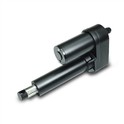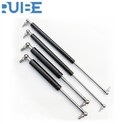Installing bonnet gas struts is a task that requires a certain set of tools to ensure a smooth and successful process. As a trusted Bonnet Gas Struts supplier, I've witnessed firsthand the importance of having the right equipment for the job. In this blog post, I'll walk you through the essential tools needed to install bonnet gas struts and provide some insights to make your installation experience hassle - free.
1. Socket Set
A socket set is an indispensable tool when it comes to installing bonnet gas struts. Most bonnet gas struts are attached to the vehicle's bonnet and body using bolts. The socket set allows you to easily loosen and tighten these bolts. You'll want to have a variety of socket sizes on hand, as different vehicles may require different bolt sizes. A standard socket set usually includes sockets ranging from 8mm to 19mm, which should cover most common applications. For example, if you're working on a small - sized car, you might need an 8mm or 10mm socket to remove the bolts holding the old gas struts. On larger vehicles, 13mm, 15mm, or even 19mm sockets could be necessary.
2. Wrenches
In addition to the socket set, a set of wrenches can be very useful. Adjustable wrenches are particularly handy as they can be adjusted to fit different bolt and nut sizes. They are great for those situations where you might not have the exact socket size available. For instance, if you encounter a stubborn bolt that doesn't seem to fit perfectly with your sockets, an adjustable wrench can come to the rescue. You can also use combination wrenches, which have an open - end on one side and a box - end on the other. The open - end can be used to quickly get onto the bolt, while the box - end provides a more secure grip for tightening or loosening.
3. Pliers
Pliers are another essential tool for installing bonnet gas struts. They can be used for a variety of tasks, such as removing cotter pins or holding small parts in place. Needle - nose pliers are especially useful as they can reach into tight spaces. When installing the gas struts, you might need to remove cotter pins that hold the mounting brackets in place. Needle - nose pliers can easily grip and pull out these small pins. Slip - joint pliers are also handy as they can be adjusted to fit different sizes of objects. You can use them to hold nuts or bolts while you're working on the installation.
4. Screwdrivers
Screwdrivers are often overlooked but can play a crucial role in the installation process. Some vehicles may have small screws that hold the bonnet lining or other components in place. You'll need both flat - head and Phillips - head screwdrivers to handle different types of screws. For example, if you need to remove the bonnet lining to access the gas strut mounting points, a Phillips - head screwdriver might be required to remove the screws. A flat - head screwdriver can be used for tasks like prying open small covers or adjusting some components.
5. Jack and Jack Stands
If you're working on a vehicle, it's important to have a jack and jack stands. The jack is used to lift the vehicle to a safe height so that you can access the bonnet gas struts easily. Make sure to use a high - quality jack that is rated for the weight of your vehicle. Once the vehicle is lifted, place the jack stands under the appropriate lifting points to ensure the vehicle remains stable. Never rely solely on the jack to support the vehicle, as it could slip and cause serious injury.
6. Safety Equipment
Safety should always be a top priority when working on any vehicle. You'll need safety glasses to protect your eyes from any debris that might fly up during the installation process. Gloves are also important as they can protect your hands from sharp edges, grease, and other contaminants. A dust mask can be useful if you're working in a dusty environment.
7. Lubricant
Applying a lubricant to the moving parts of the gas struts and the mounting points can make the installation process smoother and also extend the lifespan of the gas struts. Silicone - based lubricants are a good choice as they are non - corrosive and can provide long - lasting lubrication. You can apply the lubricant to the ball joints, mounting brackets, and any other areas where there is friction.


8. Measuring Tape
A measuring tape can be helpful to ensure that the gas struts are installed correctly. You may need to measure the distance between the mounting points on the bonnet and the vehicle body to make sure the gas struts are the right length. This is especially important if you're replacing the old gas struts with new ones. Incorrectly sized gas struts may not function properly and could even cause damage to the bonnet or the vehicle.
9. Hammer
A small hammer can be used to gently tap the gas struts into place if they are a bit stubborn. However, be careful not to use too much force as it could damage the gas struts or the mounting points. A rubber - mallet is an even better option as it provides a softer impact.
Installation Tips
Before you start the installation process, make sure to read the manufacturer's instructions carefully. Different vehicles and gas struts may have specific installation requirements. It's also a good idea to have a friend or colleague help you, especially when lifting the bonnet. This can make the process safer and more efficient.
If you're looking for high - quality Bonnet Gas Struts, look no further. Our Bonnet Gas Struts are designed to provide reliable performance and long - lasting durability. We also offer a wide range of other gas spring products, such as Murphy Bed Gas Spring and Gas Spring for Kitchen Cabinet.
If you have any questions about our products or the installation process, or if you're interested in purchasing our Bonnet Gas Struts, please don't hesitate to contact us. We're here to assist you with all your gas spring needs.
References
- "Automotive Repair Manuals" - General automotive repair literature that provides detailed information on vehicle components and installation procedures.
- Manufacturer's instructions for Bonnet Gas Struts, which offer specific guidance on installation and maintenance.






